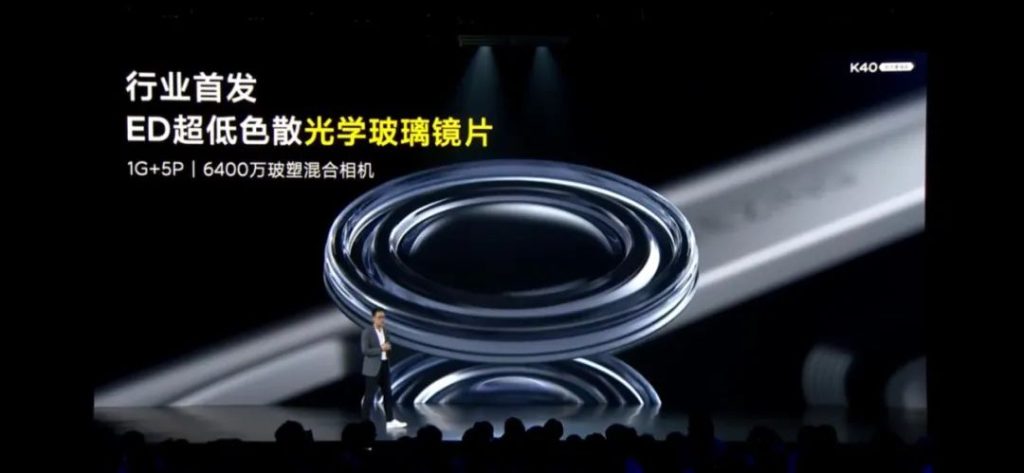“In the plastic-dominated world of cell phone lenses, the pure wafer lens has emerged as the first of its kind”

The world’s first cell phone with an WLG glass-plastic hybrid lens, the Xiaomi Redmi K40 Gaming Plus, was officially unveiled on April 27. Adopting a 1G5P (1 glass lens + 5 plastic lenses) configuration, the solution is provided by AAC OPTICS, the world’s sole owner of WLG wafer-level glass technology.
As the world’s leading optical solutions provider, AAC OPTICS is constantly exploring how to capture light and use it for the ultimate image experience. Together with Redmi, AAC OPTICS has innovatively brought the ED ultra-low dispersion optical glass lens used in SLR lenses to high-end cell phone imaging, breaking the physical performance limitations of traditional plastic lenses for cell phones and launching the era of WLG lenses for cell phone imaging.
 Photo of the launch
Photo of the launch
The product director of Redmi said at the launch that this new technology for professional imaging brings consumers a better imaging experience and expects that an increasing number of flagship phones will use glass lenses in the next year or two.
According to AAC OPTICS’ R&D engineers, WLG lenses intake more light than plastic lenses, which boosts image quality and richness. Glass lenses have lower dispersion, which ensures that all types of light wavelengths focus on the same point. As a result, cell phones can take images that show a strong contrast between light and dark with little color distortion, which reduces chromatic aberration and makes image reproduction more realistic. At the launch, Redmi showcased the following superior features of the glass-plastic hybrid lenses:
Large aperture
The camera lens of Xiaomi Redmi K40 Gaming Plus is made of optical glass with ultra-low dispersion. The unique optical design allows the lens to have a large aperture, which increases light intake by more than 15%, resulting in brighter shots and better image dynamics.

This moose pendant shot by a glass-plastic hybrid camera is much clearer
The lens also lowers ISO noise and image smearing from processing and provides richer detail in night shooting conditions.

Clearer detail processing in dark-light conditions
Reduced flare and ghosting
Due to the stronger thermal stability of glass lenses over plastic ones, combined with AAC OPTICS’ unique lens spray/black coating technology and ultra-low reflection coating process, the Xiaomi Redmi K40 Gaming Plus lens undergoes an 8-layer coating process to suppress ghosting and glare effects, enhancing the overall shooting experience for users.

No flare occurs under complex lighting – even the hairline is clear
WLG lens has a wide range of future applications
With the increasingly demanding requirements of users for high-quality phone images, the specifications of cell phones’ main cameras, telephotos, ultra-wide angle, periscope, ToF, and other functions are increasing. This in turn raises requirements on expectations for lens design height, stability, and resolution level. Plastic lenses have encountered bottlenecks in terms of optical performance, such as imaging clarity and distortion rate, as they approach performance limits. As glass lenses allow for low dispersion, high light intake, and thermal stability, glass-plastic hybrid lenses have greater flexibility in terms of lens design, aperture size, and resolution, thereby breaking through the current bottlenecks of imaging technology. The addition of glass lenses also reduce lens height, which is more conducive to matching the camera module with a large target surface sensor that can make the phone thinner and lighter.
Glass aspherical lenses allow for greater design space and higher precision in the automotive sector. As ADAS applications continue to expand, automotive cameras, as the main sensor, play a greater role, which will raise requirements for lens pixels, precision, and stability.

However, the mass production of glass lenses is not easy, as it requires extremely high process technology and precision. AAC OPTICS’ WLG technology is tens of times superior to traditional technologies in terms of production capacity. It achieves more than 100 cavities in 1 mode and can produce a variety of high-precision aspheric glass lenses with higher matching and precision. It is believed that the WLG-based glass-plastic hybrid lenses will be widely used in smartphones, automobiles, wearable devices, smart homes, security, industry, healthcare, and other emerging markets in the future as WLG technology develops.
Read more
| The sound system of the Xiaomi Redmi K40 Gaming Plus features a dual-speaker module provided by AAC, with large, high-sensitivity speakers at the top and bottom, as well as a closed dual independent cavity structure. These features greatly enhance the volume and low-frequency performance of the sound.
For gaming, the Xiaomi Redmi K40 Gaming Plus can accurately reproduce sound effects such as gunshots and explosions, making it easy for players to understand their surroundings and stay one step ahead in tournaments. It also comes with a high-quality microphone developed by AAC and a unique 3MIC design for clearer gaming voice quality. The Xiaomi Redmi K40 Gaming Plus is equipped with AAC’s X-axis linear actuator and RichTap® haptic feedback solution, which delivers high-quality vibrations. With the launch of the high-quality vibration system in Game for Peace, users can experience rich, multi-dimensional, detailed and scenario-based vibration effects on character behavior, weapons, and vehicles. More applications will be available in the future, allowing more consumers to discover the magic power of haptic feedback. |

